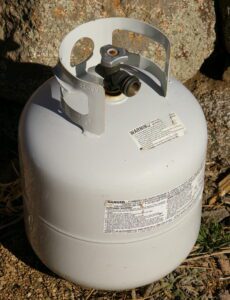Share via:
Propane tanks are common in homes because they’re often used to power cooking, heating, and other appliances. Many people use them for their barbecue grills as well.
One of the most common questions people ask is “How to store propane tanks in winter when not in use? “

Propane tanks are meant to be used for a specific use, so it makes sense to keep them in storage for that purpose.
Propane tank storage might not seem like a big deal, but make sure they’re stored in a safe location that is important for both personal safety and the longevity of the tanks.
We’ve got some great ideas here to help you find the best and safe place to store your propane tank.
Table of Contents
Where to Store Propane Tank?
Propane is one of the most popular fuels for outdoor cooking. It is clean burning fuel and has many benefits over other types of fuel, such as being able to deliver consistent heat and having no smoke or smell.
Since propane gas is flammable, it needs to be stored safely, with little to no risk of being knocked over.
The U.S. Consumer Product Safety Commission estimates that 600 propane tank explosions happen in the United States each year. So, for safety purposes, it is important to store them appropriately.
You can store propane tanks outside in an open, ventilated area, away from any combustibles and direct sunlight. Don’t store propane tanks indoors inside the house, apartments, basements, cars, or garage. Storing propane tank indoors can often raise the temperature and even trigger a fire.
When you are not using a grill or other appliances that use gas, make sure the valves on your tanks are closed and ensure that they are stored safely where children cannot get near them.
You can even store them in a hideaway propane tank storage box.
Related > > How much does a gallon of propane weigh?
Store Propane Tank Outside in Well Ventilated, Dry Area
Propane tanks should be stored in a well-ventilated, dry outdoor area at least 10 feet away from any property or other flammable objects.
While storing propane tanks outside ensures that there are enough vents to release any gas that is produced. The best place to store your tank is in a detached shed, deck, patio, or garage if you can’t put it outside on the ground.
These structures provide protection from direct sunlight, while also providing ventilation, which protects the tank in warm and cold weather.
Always store a propane tank on a flat, level outdoor area that is out of direct sunlight and rain. The outdoor area should be shaded and dry because if it’s wet outside because of rain or snow, water can seep into the tank and cause rust.
To avoid any potential problems, be sure to keep your tank out of hot sunlight and don’t leave it out on rainy days. To stabilize a tank so it remains in an upright position, use a tank foot. It will also help in preventing rust.
Try to find an area that has a lot of shade instead. Avoid leaving the tank outside where it will get wet from rain or a spot from the sun which can lead to rusting.
To protect Barbecue Propane tanks you can use a weather-resistant propane tank cover. These covers are made up of durable UV & weather-resistant fabric that adds an insulating layer to help prevent tank freeze.
You can store a propane tank anywhere outdoors with this cover. The Propane Tank Cover is UV resistant up to 2000 hours in the sun, so you can store the propane tank in sunlight or rain with this cover.
How to Store Propane Tank in Summer?
In summer, the risk of having a propane tank burst is very high. It’s important to store it somewhere safe.
If you’re storing a full tank, propane needs to be held at about 50 degrees centigrade(120 F) or colder. You’ll want to cut out any direct sunlight the tank may get so it doesn’t exceed the temperature of 120 degrees Fahrenheit.
You should keep the tank in an upright position in a shaded spot so sunlight doesn’t hit it for long periods of time—this will maintain the tank’s safe temperature. Because as the temperature rises, the gas pressure inside the tank also rises.
Propane tanks have pressure-release valves that are designed to add a vent in case a propane tank is subjected to an overfilled/overheated condition.
How much does a Propane tank weigh?
This can be useful for keeping the propane pressure at a safe level, and it helps to release built-up gas into the open atmosphere.
Ensure there are no sources of ignition near the tank so excess pressure does not trigger a fire.
How to Store Propane Tanks in Winter?
If you are going to store your tank for the winter, then be sure to take these steps beforehand:
You can store propane tank under any covered area like an awning or patio or deck. While storing propane tank for the grill in cold weather, make sure that the temperature of the tank should be above −40 °F (−40 °C).
Keep your tank full to avoid low pressure when the temperature drops. If your gas tank is less than 25% full, we highly recommend that you refuel immediately. This is especially the case for tanks with little room left – they lose pressure more quickly.
Always check your gas tank, hoses, and valves for signs of any damage or leakage. A soap and water mixture is a great way to check for leaks. If there is any bubbling, it is more likely that there is a leak. You should not keep a tank that is leaking.
A leaking propane tank can cause a variety of problems, ranging from property damage to an explosion. Propane is heavier than air and will pool in low areas, so make sure you check these areas for leaks.
Propane Tank Safety Tips
Whether you are grilling or just storing your tank, learn how to stay safe with these propane tank safety tips.
1: Store Propane tank Outside
Do not bring your propane tank indoors for any reason. All propane usage inspections storage or refills should be done outside.
2: Keep your Propane Tank upright and secure
We recommend using a tank foot or other tank holder while storing propane tank to keep it stable. You can also use a milk crate to store it.
3: Check for Leaks
Wipe down your propane tank with a solution of soapy water to check for leaks. If a leak is present, bubbles will form. And if you find a leak, turn the valve off and check the system.
4. Stay Aware
Propane in its natural state is odorless and rotten egg odor is added to propane for safety. If you notice the smell, remove any source of flame from the area, turn the valve off, and have your propane tank serviced.
5: Be Cautious
Do not smoke or light an open flame near propane tanks.
6: Do not leave your propane tank in an enclosed vehicle
Never leave your propane tank in an enclosed vehicle. This will cause the pressure relief valve to open filling your car with dangerous flammable, explosive propane vapor. If this happens, call the fire department right away.
7: Empty new tanks before use
When a propane tank is manufactured, the air gets into the tank.
The air needs to be purged from the tank for two reasons. -one the air can cause the odor that is added to the propane to fade
– Two, when propane is added to the air, there are two of the three items needed for a fire. All that is needed. There’s a small spark and the tank can explode.
8: Have a propane tank requalified
If your tank is 12 years or older, it must be re-qualified before it is safe for refill or usage. Find a local commercial dealer to re-qualify your tank. After the tank has been re-qualified, your tank is good for another five years.
9: Equip Your Tank With An OPD Valve
Small vertical propane cylinders, 40 pounds and smaller must be equipped with an overfill protection device. Before using your small cylinder, make sure to properly equip it with an OPD valve.
OPD valve prevents overfilling of a propane tank by shutting off the flow of gas once it has reached capacity.
Reference:s
https://www.amerigas.com/about-propane/propane-safety/tank-storage
https://www.uhaul.com/Blog/2017/02/22/how-to-safely-store-your-propane-tank/
I am a writer, editor, and publisher of Grillcuisines.com – an online blog dedicated to sharing grilling tips, accessories, and recipes to encourage more people to get outside and grill.
I’m off to find out the different types of grill foods, their seasons, and how to conduct outdoor cooking properly. I’ll also show you some of my grill-worthy cooking tools & accessories!







